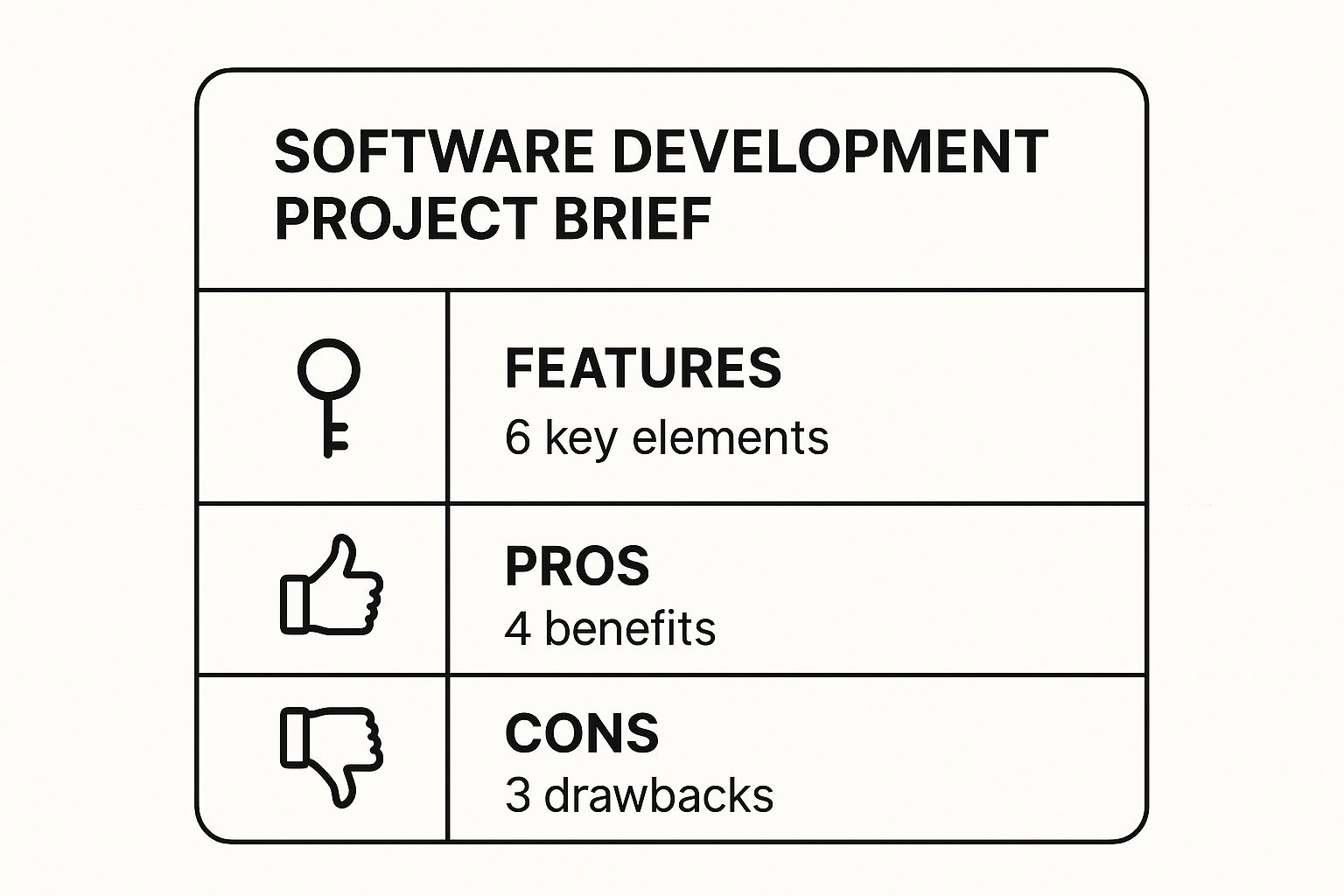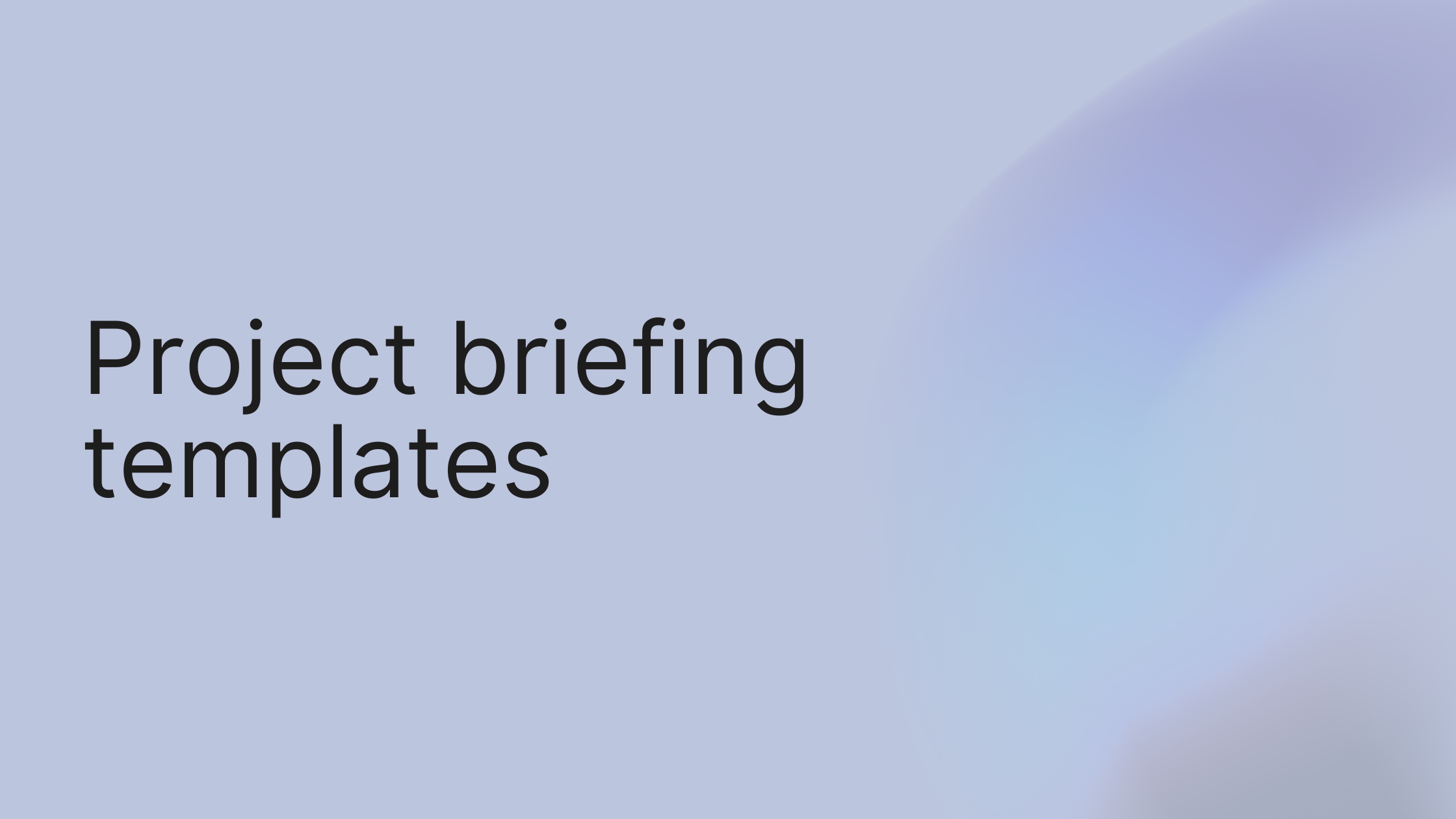Ever launched a project that felt doomed from the start? Misaligned teams, shifting goals, and endless "quick questions" that derail your entire week. It's a universal pain point for project managers. The quick win? A rock-solid project brief. This isn't just another document; it's the strategic blueprint that turns chaos into clarity before the project even kicks off.
This guide provides actionable, step-by-step guidance—no fluff. We're diving into real-world project briefing examples tailored for different industries, from software development to marketing. For each project briefing example, we'll break down its core components, analyze the strategic thinking, and give you a tactical blueprint you can use immediately. Let's move from chaotic kickoffs to clear, confident project execution.
1. Software Development Project Brief
Ever seen a software project spiral out of control because the dev team and stakeholders had completely different ideas about the final product? A poorly defined scope is a fast track to missed deadlines. The quick win is an ironclad Software Development Project Brief that aligns everyone before a single line of code is written.
This brief is a comprehensive blueprint detailing the requirements, scope, timeline, and deliverables for a software project. It serves as the single source of truth for development teams, product managers, and stakeholders, ensuring everyone understands what needs to be built, why it's needed, and how success will be measured.
Real-World Use Case: Slack's Enterprise Security Rollout
For a powerful project briefing example, consider Slack's development of its Enterprise Key Management (EKM) feature.
- The Problem (Why): Large corporate clients needed granular control over their data for security and compliance, creating a barrier to adoption.
- The Solution (What): Develop a feature allowing customers to use their own encryption keys to control access to their messages and files within Slack.
- Execution (How): The brief would have detailed technical specs, user stories (e.g., "As a security admin, I can revoke key access to lock down data instantly"), performance benchmarks, and a clear "Definition of Done."
This level of detail ensured the engineering team built a feature that precisely met market demands and unlocked a new enterprise customer segment.
This summary box provides a quick reference to the core components, benefits, and potential challenges of using a software development brief.

As the visualization highlights, while the brief provides immense clarity, its primary drawback is the significant upfront investment required. However, this initial effort pays dividends by preventing costly rework later.
Why It's a Top-Tier Briefing Method
A Software Development Project Brief is essential because it translates a business need into an actionable technical plan. It minimizes ambiguity, which is the enemy of efficient development.
- Step 1: Define Goals & Scope: Force stakeholders to agree on project goals and what constitutes the final product.
- Step 2: Prevent Scope Creep: With defined features and a clear "definition of done," it's easy to manage requests that fall outside the initial agreement.
- Step 3: Allocate Resources: A clear plan allows for accurate estimation of time, budget, and personnel. While similar to a formal proposal, a brief is more focused on execution; you can learn more about the differences in this guide to project proposals.
Pro Tip: When creating your brief, include a "Non-Goals" section. Explicitly state what the project will not accomplish. For example, "This initial release will not include a public-facing API." This proactively manages expectations and provides even greater focus for the development team.
Ready to stop scope creep and build better software, faster? Start building your project briefs and centralize your project documentation by creating your free growlio account today.
2. Marketing Campaign Project Brief
Launched a marketing campaign that fell flat because the messaging was off, the channels were wrong, or the creative team and marketing managers weren't on the same page? A disjointed campaign wastes budget and misses targets. The quick win is to anchor your strategy with a comprehensive Marketing Campaign Project Brief that aligns every contributor around a single, unified vision.
This brief is a strategic blueprint that outlines the objectives, target audience, core messaging, channels, budget, and success metrics for any marketing initiative. It acts as the definitive guide for copywriters, designers, media buyers, and stakeholders.
Real-World Use Case: Coca-Cola's 'Share a Coke' Campaign
For a classic project briefing example, look at Coca-Cola's legendary 'Share a Coke' campaign.
- The Problem (Why): The brand needed to reconnect with a younger, more individualistic demographic and create a personal, shareable experience.
- The Solution (What): Replace the Coca-Cola logo on one side of the bottle with popular names.
- Execution (How): The brief would have detailed a multi-channel push across social media, TV, and in-store displays, with a clear call-to-action (#ShareACoke) to drive user-generated content.
This detailed brief ensured a consistent and powerful message resonated globally, leading to one of the most successful personalization campaigns ever.
This summary box provides a quick reference to the core components, benefits, and potential challenges of using a marketing campaign brief.

As the visualization shows, the brief is exceptional at ensuring brand consistency. Its main challenge, however, is accurately forecasting market response, which requires thorough research.
Why It's a Top-Tier Briefing Method
A Marketing Campaign Project Brief is crucial because it translates high-level business goals into a tangible, creative, and measurable marketing plan. It bridges the gap between strategy and execution.
- Step 1: Align Strategy: Ensure every ad, social media post, and email serves a specific, agreed-upon objective (e.g., "Increase Q3 lead generation by 20%").
- Step 2: Focus Creativity: By clearly defining the target audience, key message, and tone of voice, it gives the creative team the guardrails they need to produce effective work. In growlio, you can attach your brand style guide directly to the brief.
- Step 3: Measure Success: Establish clear Key Performance Indicators (KPIs) from the start, making it easy to measure campaign success and demonstrate ROI. While similar to a creative brief, a campaign brief has a broader scope covering all channels and analytics; this guide on creative briefs offers a more focused look.
Pro Tip: When crafting your brief, include a detailed "Customer Journey Map." Outline the specific touchpoints a customer will have with your campaign, from awareness (seeing a social media ad) to conversion (making a purchase). For each stage, define the channel, the message, and the desired action. This ensures a cohesive experience.
Ready to launch campaigns that hit their mark every time? Start building your marketing briefs and organize all your campaign assets by creating your free growlio account today.
3. Construction Project Brief
Driven past a construction site that seems stalled for months, a silent monument to delays and spiraling costs? This happens when the client's vision and the contractor's execution plan are built on different foundations. The quick win is a robust Construction Project Brief, a master document that ensures everyone is working from the same set of blueprints.
This brief is the bedrock of any physical build, outlining everything from site surveys and material specifications to regulatory compliance and safety protocols. It acts as the primary reference tool, minimizing costly misunderstandings and on-site errors.
Real-World Use Case: The Burj Khalifa
For a powerful project briefing example, imagine the early planning for the Burj Khalifa.
- The Problem (Why): To build the world's tallest structure, overcoming unprecedented engineering and logistical challenges.
- The Solution (What): Design a "buttressed core" structural system and pioneer new construction techniques for extreme heights.
- Execution (How): The brief would have been immense, detailing the unique concrete mix needed to withstand extreme temperatures, the advanced "climbing" formwork system, and the logistics of moving materials and workers nearly a kilometer into the sky.
This detailed brief allowed thousands of contractors and suppliers to coordinate seamlessly on one of the world's most complex construction projects.
Why It's a Top-Tier Briefing Method
A Construction Project Brief is critical because it translates an abstract architectural concept into a concrete, buildable reality. It mitigates the immense risks inherent in construction by demanding granular detail upfront.
- Step 1: Ensure Safety & Compliance: Mandate that all plans adhere to strict building codes, safety regulations, and environmental standards.
- Step 2: Control Budget & Schedule: Detail all materials, labor, and timelines to create a baseline for tracking costs and progress, preventing unforeseen expenses.
- Step 3: Manage Stakeholders: Provide a clear, shared understanding of the final structure, its quality standards, and its functional requirements. The level of detail required is similar to what's outlined in a scope of work, a topic you can explore further in these scope of work examples.
Pro Tip: Integrate a formal Change Order Management process directly into your brief. Define the exact procedure for submitting, reviewing, and approving any deviation. Specify who has approval authority and how changes impact the budget. For example, "All change requests must be submitted via Form C-1 in growlio, reviewed by the project architect and lead engineer within 48 hours, and require client sign-off before implementation."
Ready to lay a solid foundation for your complex projects? Start documenting requirements and managing timelines by creating your free growlio account today.
4. Event Planning Project Brief
Attended a corporate event where the schedule was chaotic, vendors were confused, and the experience felt disjointed? This stems from a failure to communicate a unified vision. The quick win is to anchor every decision with a detailed Event Planning Project Brief, the master document that transforms a high-level concept into a flawlessly executed experience.
This brief acts as the central command center for any event, outlining every critical detail: the event's core purpose, target audience, budget, venue logistics, vendor contracts, marketing plan, and success metrics. It ensures everyone is working from the same script.

Real-World Use Case: A TED Talks Conference
For a powerful project briefing example, imagine planning a TED conference.
- The Problem (Why): Create a world-class thought leadership event that fosters the spread of innovative ideas and feels seamless for both attendees and speakers.
- The Solution (What): A meticulously curated program of speakers, each delivering a short, powerful talk on a specific topic.
- Execution (How): The brief would go far beyond just booking a stage. It would define a precise run-of-show schedule down to the minute, specific technical requirements for each presentation (mics, slides, props), and a detailed audience profile for curation.
This level of detail is what creates the high-impact experience TED is known for.
As the process illustrates, a successful event depends on the flawless coordination of countless moving parts, a feat made possible by a strong initial brief.
Why It's a Top-Tier Briefing Method
An Event Planning Project Brief is indispensable because it translates an ambitious vision into a series of coordinated, practical tasks. It creates order out of potential chaos.
- Step 1: Synchronize Execution: Ensure all parties, from catering to AV technicians, understand their roles and timelines. Use a shared brief in growlio to keep vendors aligned.
- Step 2: Control the Budget: Detail all expected costs upfront to prevent budget blowouts and allow for smarter spending decisions.
- Step 3: Plan for Contingencies: A thorough brief forces planners to anticipate potential issues (e.g., bad weather for an outdoor event, a speaker cancellation) and build contingency plans from the start. A key component is a detailed schedule, and you can master this by learning more about creating project timelines.
Pro Tip: In your brief, include a "Run-of-Show" document—a hyper-detailed, minute-by-minute timeline for the event day. Also, add a "Communications Plan" section outlining who is responsible for communicating with which stakeholder group (vendors, attendees, sponsors, press), the frequency, and the channels to be used. This becomes the on-site bible for the entire production team.
Ready to orchestrate unforgettable events without the chaos? Start building your event briefs and manage all your project moving parts by creating your free growlio account today.
5. Research Project Brief
Started a research project only for the goalposts to shift halfway through, leading to inconclusive results and wasted effort? Without a clear framework, research can meander and fail to produce meaningful insights. The quick win is a robust Research Project Brief that ensures every step of the inquiry is purposeful and methodologically sound.
This brief defines the research objectives, methodology, scope, and deliverables. It serves as the guiding charter for researchers and stakeholders, ensuring everyone agrees on the questions being asked, the methods used to answer them, and how the findings will be interpreted.
Real-World Use Case: Pew Research Center Studies
For an excellent project briefing example, consider the Pew Research Center's studies on social media usage.
- The Problem (Why): Understand how digital communication habits are changing across different demographics to inform public discourse and policy.
- The Solution (What): Conduct a large-scale national survey asking specific questions about platform usage, frequency, and user sentiment.
- Execution (How): The brief would precisely define the methodology: sampling strategy (e.g., random-digit-dialing), sample size, margin of error, question wording, and the data analysis plan.
This rigorous upfront planning ensures the results are credible, defensible, and truly reflective of the population being studied.
Why It's a Top-Tier Briefing Method
A Research Project Brief is critical because it brings discipline and rigor to the process of discovery. It transforms a broad curiosity into a focused, measurable, and repeatable investigation.
- Step 1: Define the Methodology: Force a clear definition of hypotheses, variables, and data collection procedures, which is the cornerstone of valid research.
- Step 2: Ensure Laser Focus: By outlining specific research questions, it prevents the project from drifting into tangents, saving time and resources.
- Step 3: Facilitate Funding & Review: For academic and grant-funded projects, a detailed brief is often a prerequisite, demonstrating a well-considered plan. While this brief focuses on methodology, accurately forecasting the resources needed is also key. You can find help in our guide covering different project estimation techniques.
Pro Tip: In your Research Project Brief, include a "Data Management and Validation Plan." Detail the specific procedures for data cleaning, how you will handle missing values, and the protocols for validating data integrity. For example, "All survey responses will be cross-checked for logical inconsistencies, and outliers will be analyzed using the IQR method before statistical analysis." This adds a layer of credibility to your findings.
Ready to conduct more focused, impactful research? Start standardizing your research plans and manage all your project documents in one place by creating your free growlio account today.
6. Product Development Project Brief
Ever launched a new product only to find it completely misses the mark with your target audience? This stems from a lack of shared vision between product, engineering, and marketing. The quick win is a meticulously crafted Product Development Project Brief that ensures every team is building the same product for the same user.
This brief acts as the North Star for bringing a product to life, from initial concept to market launch. It outlines the product vision, identifies the target user and their problems, defines success metrics, and details the core features.
Real-World Use Case: Instagram's "Stories" Feature
For a powerful project briefing example, consider the launch of Instagram's "Stories" feature.
- The Problem (Why): Combat the existential threat of Snapchat by offering a space for ephemeral, casual content that lowered the barrier to posting.
- The Solution (What): Develop a feature for sharing photos and videos that disappear after 24 hours, displayed prominently at the top of the main feed.
- Execution (How): The brief would have defined the core user flow, UI/UX design principles (tapping to advance, holding to pause), and integration with the existing app.
This clarity allowed Instagram to rapidly develop and deploy a feature that fundamentally changed its platform and user engagement.
Why It's a Top-Tier Briefing Method
A Product Development Project Brief is indispensable because it translates a market opportunity into a tangible product roadmap. It bridges the gap between a high-level idea and the detailed execution required to build it successfully.
- Step 1: Define Product-Market Fit: Force a deep dive into user personas and problems upfront, increasing the likelihood that you build something people actually want. Use the growlio brief template to outline your user personas.
- Step 2: Align Cross-Functional Teams: Serve as a single source of truth, preventing silos and ensuring marketing campaigns, sales pitches, and feature development are all in sync.
- Step 3: Define Success Clearly: Establish key performance indicators (KPIs) like "Daily Active Users of Stories" or "Average Stories Viewed Per User" from the start. While a product brief focuses on the 'what' and 'why,' a consulting proposal often details the 'how' of service delivery; you can explore this further in these examples of winning consulting proposals.
Pro Tip: Integrate a "User Testing and Feedback Loop" section directly into your brief. Outline the plan for gathering user feedback at critical stages. For example, specify: "We will conduct 5 moderated usability tests with the Figma prototype before engineering kickoff" or "A/B test the onboarding flow with 10% of new users in the first month." This builds continuous improvement into the product's DNA.
Ready to build products that resonate and win the market? Start building your product briefs and unify your teams by creating your free growlio account today.
Project Briefing: 6 Key Examples Comparison
| Project Brief Type | Implementation Complexity 🔄 | Resource Requirements ⚡ | Expected Outcomes ⭐ | Ideal Use Cases 💡 | Key Advantages 📊 |
|---|---|---|---|---|---|
| Software Development | High upfront time; detailed technical specs needed | Skilled developers, QA, tech stack | Clear scope, reduced miscommunication | Building software with defined features | Accurate estimation, resource planning |
| Marketing Campaign | Moderate; requires extensive market research and strategy | Marketing teams, research, creative resources | Consistent messaging, measurable KPIs | Brand awareness, product promotion | Budget optimization, cross-team collaboration |
| Construction | High; requires technical expertise and regulatory compliance | Engineers, architects, contractors, permits | Minimized change orders, regulatory adherence | Complex physical builds and infrastructure projects | Clear accountability, bidding accuracy |
| Event Planning | Moderate; involves detailed advance planning | Vendors, logistics coordinators, event teams | Seamless execution, risk mitigation | Corporate events, launches, conferences | Vendor coordination, budget control |
| Research | High; requires rigorous methodology and ethical oversight | Researchers, data collection tools, IRB approval | Scientific rigor, reproducibility | Academic, clinical, or commercial research | Peer validation, ethical compliance |
| Product Development | High; ongoing updates aligned with market and user feedback | Cross-functional teams, market research | Aligned vision, clear success metrics | New product launches, feature enhancements | Data-driven decisions, resource prioritization |
From Briefing to Breakthrough: Your Next Step
Throughout this guide, we've dissected a diverse range of project briefing examples. Each example reinforces a universal truth: a project's success is often decided long before the first line of code is written, the first ad is designed, or the first brick is laid. It begins with the clarity and alignment forged in a powerful brief.
The core takeaway is that a project brief is not merely administrative paperwork; it's a strategic instrument. It’s the foundational document that transforms a vague idea into a tangible, actionable plan. It aligns stakeholders, mitigates risk, and empowers your team by providing the context and constraints needed to do their best work.
Mastering the Art of the Brief
So, what are the most critical, replicable strategies we've uncovered?
- Define "Done" from Day One: Every strong project briefing example we analyzed shared one common trait: a crystal-clear definition of success. Vague goals like "increase brand awareness" were replaced with specific, measurable outcomes like "achieve a 15% increase in branded search traffic and 500 new social media mentions within Q3."
- Context is King: The best briefs don't just state what needs to be done; they explain why. Providing the backstory, the business challenge, and the strategic importance of the project gives your team purpose and enables better independent decision-making.
- Embrace Constraints: Far from stifling creativity, clearly defined budgets, timelines, and technical limitations provide the necessary framework for innovation. Knowing the boundaries allows a team to focus their energy on finding clever solutions within those lines.
Your Actionable Path Forward
Moving from theory to practice is the most important step you can take. Don't just save these templates; adapt them. The next time a new project lands on your desk, resist the urge to jump straight into execution. Instead, block out time to draft a comprehensive brief using the principles we've discussed.
Start by selecting the project briefing example from our list that most closely matches your needs. Use its structure as your starting point, but rigorously customize each section to fit your project's specific context. Involve key stakeholders in the drafting process to build early buy-in and gather diverse perspectives. Treat the finished document as a living agreement, the central point of reference for every decision to come.
Ready to stop chasing scattered emails and start building breakthrough projects from a single source of truth? The templates in this article are a powerful start, but managing them across multiple projects requires a dedicated system. growlio centralizes all your project briefs, client details, and team communication in one streamlined platform. Turn your next great brief into a flawlessly executed project. Your clear next step is to start your free growlio account at growlio.io today.
